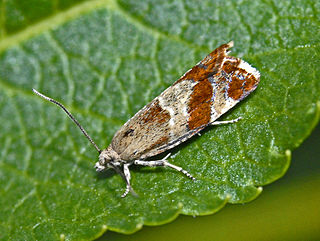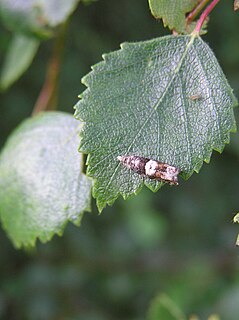
Epinotia immundana is a moth of the family Tortricidae. It is found in China (Qinghai), Russia and Europe.

Choristoneura lambertiana, the sugar pine tortrix, is a moth of the family Tortricidae. It is found in the eastern parts of North America and the northern regions of the United States.

Epinotia cruciana, the willow tortrix, is a moth of the family Tortricidae.

Epinotia nanana, the European spruce needleminer, is a moth of the family Tortricidae. It is found from northern and central Europe to Russia and Mongolia.

Epinotia tenerana, the nut bud moth or alder tortricid, is a moth of the family Tortricidae.
Retinia monopunctata is a moth of the family Tortricidae. It is found in Japan, northern China and Russia.

Rhyacionia duplana, the summer shoot moth or Elgin shoot moth when referring to subspecies logaea, is a moth of the family Tortricidae. It is found from northern and central Europe to eastern Russia, China and Japan. It has also been reported from Korea, but it has not been found in recent studies.

Rhyacionia pinicolana is a moth of the family Tortricidae. It is found from northern and central Europe to eastern Russia, China, Japan and Korea.

Zeiraphera ratzeburgiana, the spruce bud moth or Ratzeburg tortricid, is a moth of the family Tortricidae. It is found from northern and central Europe to eastern Russia and China. Zeiraphera ratzeburgiana is a taxonomically similar species to Zeiraphera canadensis and can only be distinguished by an anal comb found in Z. canadensis.
Zeiraphera rufimitrana, the red-headed fir tortricid, is a moth of the family Tortricidae. It is found from central Europe to eastern Russia, Mongolia, the Korean Peninsula, China and Japan. It was first recorded from the Netherlands by Kuchlein and Naves in 1999.
Cydia cosmophorana is a moth of the family Tortricidae. It is found from northern and central Europe to eastern Russia.

Epinotia brunnichana is a moth of the family Tortricidae. It is found in most western, central and northern Europe, the Near East and further east to the eastern Palearctic realm, where it has been recorded from Russia, Kazakhstan, China, and Japan.

Epinotia demarniana is a moth of the family Tortricidae found in most of Europe, east to the eastern part of the Palearctic realm.

Epinotia tetraquetrana, the square-barred bell, is a moth of the family Tortricidae. It is found from most of Europe east to the Near East and the eastern part of the Palearctic realm.

Epinotia cedricida is a species of moth of the family Tortricidae. It is found in Morocco, Algeria, Lebanon and Turkey. It is an introduced species in Europe, where it has been recorded from south-eastern France, Spain and Austria.

Epinotia trigonella, the birch epinotia moth, is a species of moth of the family Tortricidae. It is found in most of Europe, east to the eastern Palearctic realm. It is also found in North America.
Epinotia pinicola is a species of moth of the family Tortricidae. It is found in China, Korea, Japan and Russia.
Retinia immanitana is a species of moth of the family Tortricidae. It is found in China and Russia.
Acleris kodamai is a species of moth of the family Tortricidae. It is found in South Korea, China and Japan.
Acleris longipalpana is a species of moth of the family Tortricidae. It is found in South Korea, China, Japan and Russia (Ussuri).












